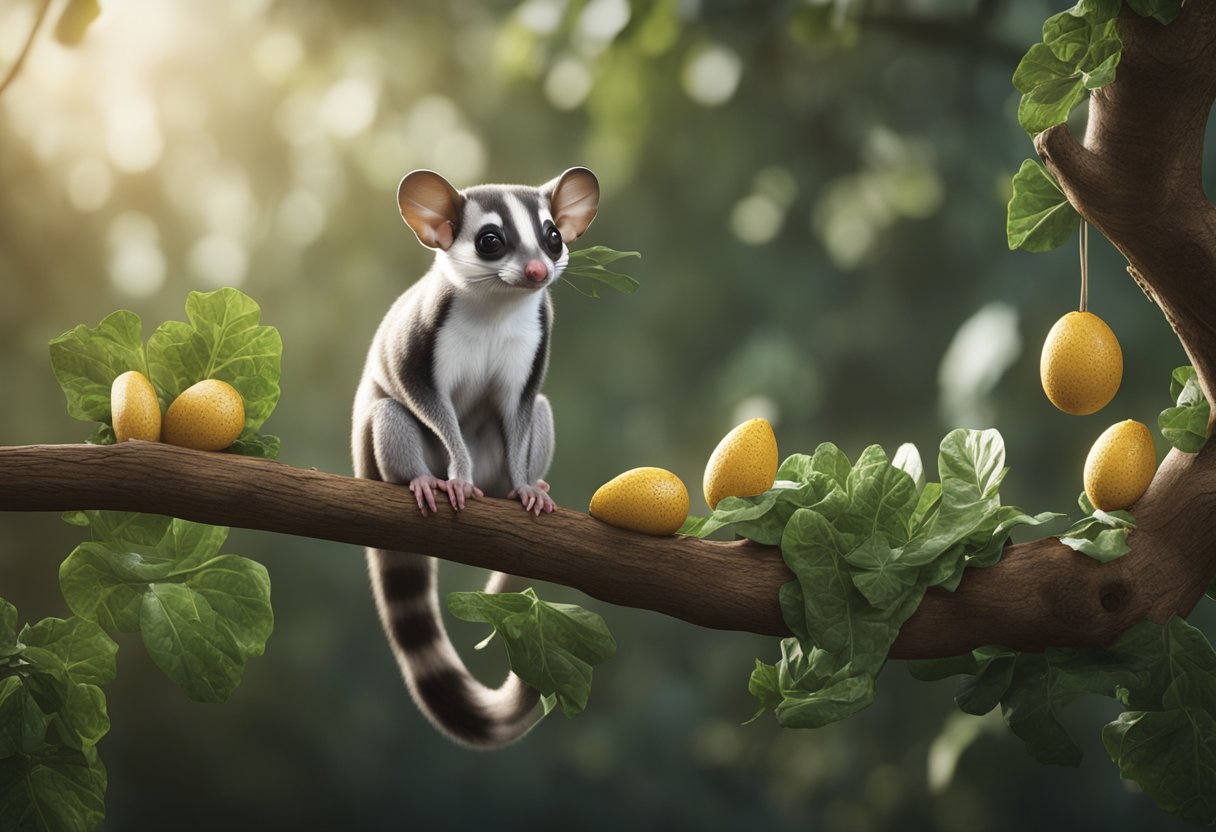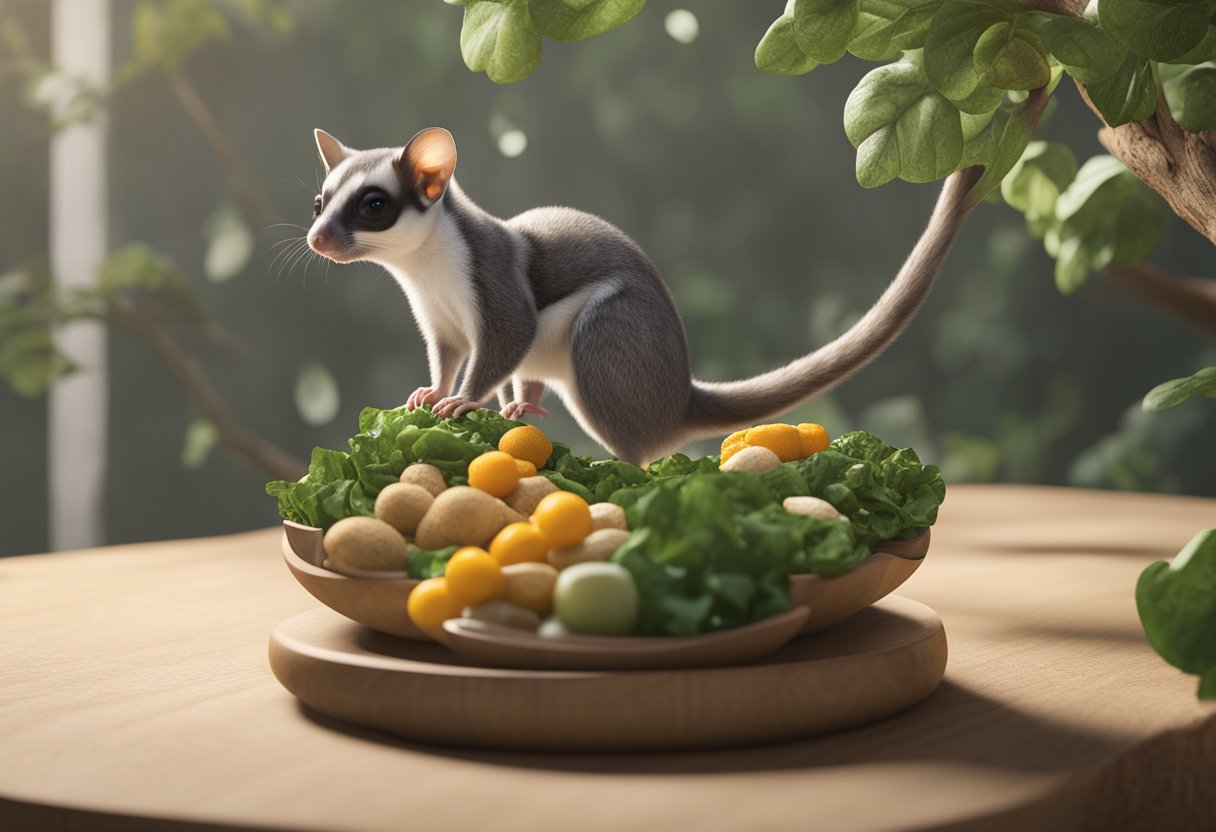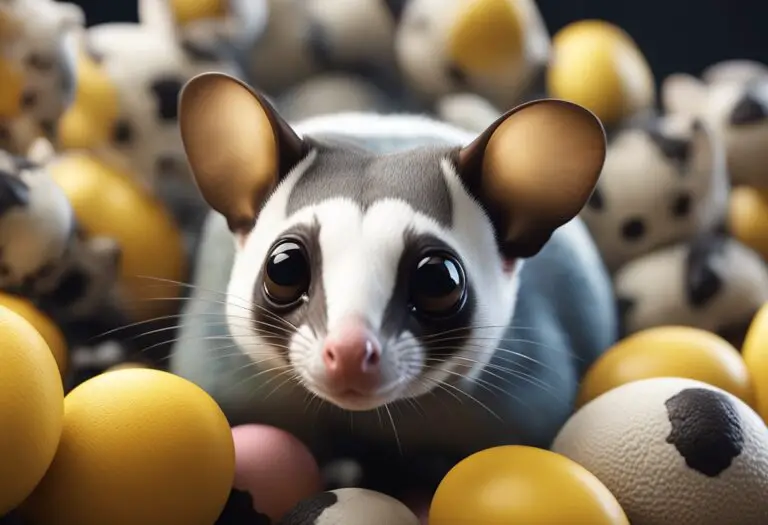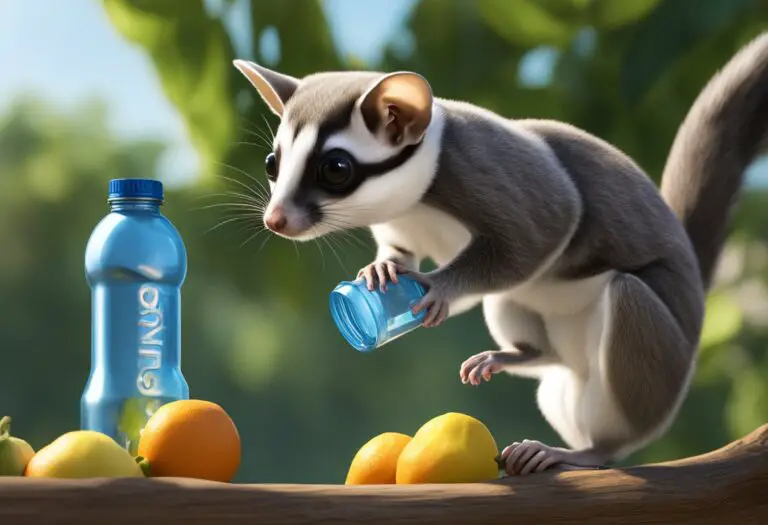Calcium Requirements for Sugar Gliders
Calcium is an essential mineral for sugar gliders, playing a crucial role in their overall health and well-being. This article will delve into the specific calcium requirements for sugar gliders, explore the importance of proper calcium intake, and provide practical tips for ensuring your sugar glider receives the necessary amount of this vital nutrient. Maintaining a balanced sugar glider nutrition that meets their calcium needs is essential for preventing metabolic bone disease and promoting the long-term well-being of these unique pets.
Understanding Calcium Needs for Sugar Gliders
Calcium is a crucial mineral for sugar gliders, as it supports the development and maintenance of strong bones and teeth. This essential nutrient also plays a vital role in nerve function, muscle contraction, and various other biochemical processes that are essential for the overall health of these delightful creatures.
Why Calcium is Crucial for Sugar Gliders
Sugar gliders require an adequate intake of calcium to ensure their skeletal system develops and functions properly. Calcium is necessary for the formation and strengthening of bones and teeth, which are particularly important for these agile, tree-dwelling pets. Without sufficient calcium, sugar gliders are at risk of developing metabolic bone disease, a serious condition that can result in weakened bones, increased fracture risk, and other health complications.
Effects of Calcium Deficiency in Sugar Gliders
A calcium deficiency in sugar gliders can lead to a range of health issues, including muscle weakness, seizures, and the development of metabolic bone disease. This condition can cause the bones to become soft and fragile, leading to an increased risk of fractures and other skeletal problems. Severe cases of metabolic bone disease can even result in deformities and life-threatening complications if not addressed promptly.
Understanding the calcium requirements for sugar gliders and the potential risks of calcium deficiency is crucial for ensuring these delicate pets receive the necessary nutrients to thrive and avoid the devastating effects of metabolic bone disease.
Sugar Glider Diet and Calcium Sources

Sugar gliders are insectivores, meaning their natural diet consists primarily of insects and other small prey. While insects can provide some calcium, they are not a reliable and consistent source of this essential mineral. Sugar gliders also enjoy a variety of fruits and vegetables, some of which can be excellent sources of calcium.
Calcium-Rich Foods for Sugar Gliders
By incorporating calcium-rich foods, such as leafy greens, squash, and certain fruits, into their diet, you can help ensure your sugar glider is getting the necessary calcium intake. These nutrient-dense options can help supplement the sugar glider diet and provide a well-rounded source of this vital mineral.
Incorporating Insects for Calcium Intake
While insects may not be the primary calcium source for sugar gliders, they can still play a role in providing this essential nutrient. By thoughtfully selecting and preparing the insects that are part of your sugar glider’s diet, you can help maximize their calcium intake and ensure a balanced nutritional profile.
Calcium Supplementation for Sugar Gliders
In addition to a balanced diet, calcium supplementation is often necessary to meet the specific calcium requirements of sugar gliders. One effective method is to dust the insects or other food items with a calcium supplement powder before feeding them to your sugar glider. This ensures your pet is getting the appropriate amount of calcium with each meal.
Dusting Insects with Calcium Powder
Dusting insects with calcium powder is a convenient way to boost the calcium content of your sugar glider’s diet. By lightly coating the insects or other prey items with the supplement, you can easily incorporate additional calcium into their daily meals. This approach helps guarantee your sugar glider is receiving the necessary calcium intake with each feeding.
Calcium Supplements and Dosage Guidelines
It’s important to follow dosage guidelines and monitor your sugar glider’s response to the calcium supplements to maintain optimal calcium levels. Oversupplementation can lead to health issues, while under-supplementation may result in calcium deficiency. Consulting with your veterinarian can help you determine the appropriate calcium supplement and dosage for your individual sugar glider’s needs.
Calcium Requirements for Sugar Gliders
Sugar gliders have unique calcium requirements that can vary depending on factors such as age, activity level, and reproductive status. Ensuring your sugar glider receives the appropriate amount of calcium is crucial for their overall health and wellbeing. Understanding the specific calcium needs of sugar gliders is the foundation for providing them with a balanced and nutritious diet.
The calcium requirements for sugar gliders can fluctuate based on the individual’s developmental stage, lifestyle, and reproductive condition. Baby sugar gliders, for instance, have higher calcium needs to support their rapid growth and bone development. Similarly, breeding and pregnant sugar gliders require increased calcium intake to sustain their own health and the development of their offspring.
Maintaining the proper calcium requirements for sugar gliders is essential for preventing conditions such as metabolic bone disease, a serious condition that can lead to weakened bones, increased risk of fractures, and other health problems. By closely monitoring your sugar glider’s calcium levels and adjusting their diet and supplementation accordingly, you can ensure they receive the necessary amount of this vital mineral.
Preventing Metabolic Bone Disease in Sugar Gliders
One of the most serious consequences of calcium deficiency in sugar gliders is the development of metabolic bone disease. This condition can lead to weakened bones, increased risk of fractures, and other health problems. By being vigilant for the signs of calcium deficiency, such as lethargy, decreased appetite, or bone deformities, and by providing a balanced diet with appropriate calcium supplementation, you can help prevent the occurrence of this potentially life-threatening condition in your sugar glider.
Signs of Calcium Deficiency to Watch For
Recognizing the early signs of calcium deficiency is crucial in addressing the issue before it leads to more severe complications. Some common indicators of calcium deficiency risks in sugar gliders include lethargy, decreased appetite, and visible bone deformities. It’s important to monitor your sugar glider’s behavior and physical appearance closely to identify any changes that may signal an underlying calcium imbalance.
Importance of a Balanced Diet and Supplements
Maintaining a balanced sugar glider nutrition is the foundation for preventing metabolic bone disease. Incorporating a variety of calcium-rich foods, such as leafy greens and squash, into your sugar glider’s diet, along with appropriate calcium supplementation, can help ensure they are receiving the necessary amount of this vital mineral. By providing a well-rounded and balanced diet, you can support your sugar glider’s overall health and prevent metabolic bone disease.
Calcium Needs During Different Life Stages
The calcium requirements of sugar gliders can vary depending on their stage of life. As these charismatic marsupials grow and develop, their nutritional needs evolve, and providing the appropriate amount of calcium becomes crucial for their overall health and wellbeing.
Calcium Requirements for Baby Sugar Gliders
Baby sugar gliders have higher calcium requirements to support their rapid growth and bone development. During this critical period, ensuring they receive adequate calcium is essential for building strong skeletal structures and promoting proper physiological function. Careful monitoring and adjustments to their diet and supplementation can help meet the calcium needs for baby sugar gliders and set the foundation for a healthy, thriving juvenile.
Calcium Needs for Breeding and Pregnant Sugar Gliders
Likewise, breeding and pregnant sugar gliders require increased calcium intake to support the development of their offspring and maintain their own health. The demands on the female’s body during gestation and lactation can deplete calcium reserves, making supplementation and a calcium-rich diet even more crucial. By addressing the calcium needs for breeding and pregnant sugar gliders, you can help ensure the health and vitality of both the parents and their young.
Adjusting the calcium supplementation and diet accordingly can help ensure your sugar glider’s calcium needs are met during these critical life stages, promoting optimal growth, development, and overall wellbeing.
Environmental Factors Affecting Calcium Absorption
The absorption and utilization of calcium in sugar gliders can be significantly influenced by various environmental factors. Understanding these environmental influences is crucial in providing your sugar glider with the optimal conditions for proper calcium absorption and utilization.
Temperature, humidity, and lighting are some of the key environmental factors that can impact the body’s ability to metabolize and utilize calcium. For instance, sugar gliders may have difficulty absorbing calcium effectively in environments that are too cold or too dry. Similarly, inadequate lighting can hinder the body’s production of vitamin D, which is essential for the proper absorption of calcium.
By carefully monitoring and adjusting the temperature, humidity, and lighting in your sugar glider’s habitat, you can create an environment that supports optimal calcium absorption and utilization. This, in turn, helps ensure your pet’s overall health and well-being, reducing the risk of calcium deficiencies and associated health issues.
“Providing the right environmental conditions is just as important as a balanced diet when it comes to supporting your sugar glider’s calcium needs.”
Regularly assessing and maintaining the appropriate environmental factors in your sugar glider’s enclosure can go a long way in promoting their overall health and preventing any environmental factors affecting calcium absorption-related problems.
Calcium and Other Nutrient Interactions
Calcium does not exist in a vacuum; it interacts with other essential nutrients, such as vitamin D and phosphorus, to maintain optimal health in sugar gliders. Understanding these nutrient interactions is crucial when formulating a balanced diet and supplementation plan for your pet.
Vitamin D and Its Role in Calcium Absorption
Vitamin D plays a pivotal role in the absorption and utilization of calcium by sugar gliders. This fat-soluble vitamin helps the body effectively absorb and regulate calcium levels, ensuring this essential mineral is available for crucial bodily functions, such as bone development and maintenance.
Balancing Calcium with Phosphorus
In addition to vitamin D, the balance between calcium and phosphorus is also crucial for sugar glider health. An imbalance between these two minerals can lead to issues such as metabolic bone disease, where the body is unable to properly utilize calcium. Maintaining the appropriate ratio of calcium to phosphorus is essential for preventing these types of mineral imbalances and supporting overall sugar glider well-being.
Tips for Ensuring Optimal Calcium Intake
Maintaining a balanced and nutritious diet is crucial for your sugar glider’s health, and this includes ensuring they receive the necessary calcium intake. One effective strategy is to rotate the calcium-rich foods you provide, exposing your pet to a variety of calcium-dense options.
Rotating Calcium-Rich Foods
Sugar gliders can benefit from a rotation of calcium-rich foods, such as leafy greens, squash, and certain fruits. By incorporating a diverse array of these calcium-rich ingredients into their diet, you can help guarantee that your sugar glider is meeting their calcium requirements consistently.
Monitoring Calcium Levels
Regular veterinary check-ups and monitoring calcium levels are essential for maintaining your sugar glider’s optimal health. Your veterinarian can perform diagnostic tests to identify any calcium deficiencies or imbalances, allowing you to make timely adjustments to your pet’s diet and supplementation regimen.
By implementing these strategies, you can help ensure your sugar glider receives the appropriate amount of calcium, supporting their overall well-being and reducing the risk of developing serious health issues like metabolic bone disease.
Common Myths and Misconceptions about Calcium
When it comes to the calcium requirements of sugar gliders, there are several common myths and misconceptions that pet owners need to be aware of. Separating fact from fiction is crucial in ensuring your sugar glider receives the appropriate amount of this essential mineral.
One prevalent myth is that sugar gliders can obtain all the calcium they need from their natural insect-based diet. While insects can provide some calcium, they are not a reliable or consistent source, and sugar gliders often require additional calcium supplementation to meet their specific needs. Relying solely on insects can lead to calcium deficiencies and associated health problems.
Another misconception is that providing a calcium supplement is sufficient on its own, without the need for a balanced diet. In reality, calcium works in conjunction with other nutrients, such as vitamin D and phosphorus, to be effectively absorbed and utilized by the body. A well-rounded diet, along with appropriate calcium supplementation, is the key to maintaining optimal calcium levels in sugar gliders.
“Addressing these common myths and misconceptions about calcium is crucial in providing your sugar glider with the necessary nutrients for their overall health and well-being.”
Some pet owners also believe that simply dusting their sugar glider’s food with calcium powder is enough to meet their calcium requirements. While this method can be effective, it’s important to monitor the dosage and ensure the calcium is being properly absorbed and utilized by the animal.
By understanding the common myths and misconceptions about calcium and relying on evidence-based information, you can make informed decisions about your sugar glider’s calcium needs and provide them with the appropriate care and nutrition they require.
Conclusion
Calcium is a vital nutrient for sugar gliders, playing a crucial role in their overall health and well-being. By understanding the specific calcium requirements for sugar gliders, incorporating calcium-rich foods into their diet, and providing appropriate supplementation, you can help prevent the development of serious conditions like metabolic bone disease and ensure your sugar glider thrives. Maintaining a balanced sugar glider nutrition and closely monitoring your pet’s calcium levels are essential for supporting their long-term health and happiness.
Ensuring your sugar glider receives the necessary amount of calcium is a fundamental aspect of responsible pet ownership. With a comprehensive understanding of their calcium needs and the ability to provide a balanced diet and targeted supplementation, you can take proactive steps to safeguard your sugar glider’s well-being and set them up for a long, healthy life.
By prioritizing calcium requirements for sugar gliders and adopting a holistic approach to their nutrition, you can contribute to the overall welfare of these fascinating creatures and foster a thriving, vibrant sugar glider companion.







